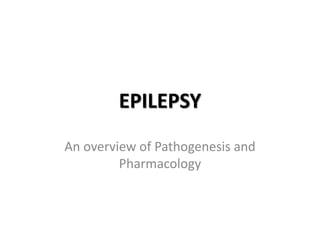
Epilepsy
- 1. EPILEPSY An overview of Pathogenesis and Pharmacology
- 2. Lecture overview 1) Define seizures and epilepsy 2) Aetiology and Pathogenesis – 1st Q&A round 3) Classification- more definitions!!! 4) Pharmacology of AEDs- 2nd Q&A round 5) Future treatments 6) Last round of Q&As
- 3. What is a seizure? • Spontaneous • Sustained discharge • Group of neurons from a focus in the brain
- 4. Then, what is Epilepsy? • An increased tendency(or decreased threshold) for seizures • (even if long time separates attacks)
- 5. Putting it together • Both definitions on the grounds of : a) Spontaneous b) Sustained c) Discharge ANYONE can get a seizure, some have epilepsy!
- 6. The concept of the seizure threshold
- 7. And putting it in context • Epilepsy IS common! • 2% of population in developed countries suffers from seizures 2, or more, times in their lifetime • In 0.5% epilepsy is an active problem • Roughly 250,000 people on AED in the UK
- 8. Aetiology and Pathogenesis To have a seizure, you need one or more of these three: 1) INCREASED excitation 2) DECREASED inhibition 3) Intrinsic hyperexcitability (jumpy neurons)
- 10. Increased excitation • Mesial Temporal Sclerosis: An example of a mechanism that leads to increased excitation and temporal lobe epilepsy • Specific pattern of neuron loss in the hippocampus
- 11. Simply: Death of inhibitory neurons and sprouting of excitatory fibers from dentate granule cells= Reverberant pathway= increased excitation in that focus
- 12. • (other stuff like kindling + LTP, important as experimental models but not in your lecture)
- 13. Decreased inhibition • Chandelier cells: A model of what might be happening. • They are GABA- ergic inhibitory • Inhibit cortical pyramidal neurons and also control excitability
- 14. Huh?- No 1
- 15. Huh?- No 2 • They can inhibit lots of pyramidal neurons at once • They inhibit at the axonal initial segment • Therefore, they inhibit where the action potential would have been initiated • Therefore, loss of inhibitory interneurons leads to decreased excitability
- 16. Intrinsic neuronal hyperexcitability • Not to do with neurotransmitters • Not to do with aberrant connections • Intrinsic problem= Involves ION CHANNELS • Need to understand action potentials to know how they work • SAY WHAT?
- 19. Channelopathies 1) NaV gated channels= eg SCN1B mutation, DECREASED inactivation and ‘slower’ closing of NaV channels 2) K+ channels= eg KCNQ2 mutation leads to ‘faster’ closing of the K+ channels and ‘less’ hyperpolarization 3) Ca2+: Activate at a lower threshold, important in the thalamus.
- 20. Aetiology- a very condensed list 1) Genetic 2) Developmental 3) Brain trauma/surgery 4) Pyrexia 5) Brain tumours 6) Vascular- eg stroke or AVM 7) Drugs and drug withdrawal inl alcohol 8) Infection and inflammation- encephalitis, MS 9) Metabolic conditions- uraemia, hypocalcaemia etc 10) Neurodegeneration- AD
- 21. Summary (so far)
- 22. Questions?
- 23. Classification: Partial Seizures One area of the cortex only. Can remain focal or can spread (and become generalised) Simple: Consciousness is not impaired Complex: Consciousness is impaired (usually temporal) (Might have to take a look what’s causing it)
- 26. Generalized Seizures- from midline(eg thalamus) to everywhere 1) Absence: or petit mal, CHILDHOOD. Stop and stare. Few seconds. Some twithces in face. May become Tonic- Clonic in adult life. Associated with T-type Ca-channel problems 2) Tonic-clonic: Tonic- LOC, contraction, cyanosis- <1m Clonic- Convulsive movements, incontinence cyanosis 2-4m Coma- Flaccid, regular breathing, colour back
- 28. Other stuff • Other types of Generalized eg myoclonic, tonic, akinetic. • (Febrile convulsions) • (Photosensitivity and Pokemon)
- 29. Status Epilepticus • Two or more tonic- clonic (usually) one after the other without regaining consciousness. • 10-15% mortality!!! • A medical emergency
- 31. Pharmacology of anticonvulsant drugs 1) Na+ voltage gated channels 2) GABAergic transmission 3) Ca2+ channels 4) Others
- 32. Na channel pharmacology Use- dependence: Block channels in inactive state and don’t let them ‘rest’ so they cannot reactivate!
- 33. Phenytoin Plus, enzyme induction, hirsutism, teratogenic etc etc etc
- 34. Carbamazepine • Microsomal enzyme inducer, ataxia, bone marrow suppression etc…
- 35. Valproate • USED IN ALL SEIZURE TYPES • Active on Ca and GABA as well • Liver toxicity, kinky hair, teratogenic
- 36. GABA- ergic 1) May act at the receptor to increase opening (eg Barbiturates or Benzo’s) 2) May decrease the re-uptake of GABA from the synapse by inhibiting the transporter GAT-1 (eg Tiagabine) 3) May irreversibly inhibit the breakdown of GABA by GABA transaminase (eg Vigabatrin)
- 37. CaCh 1) Ethosuximide- inhibits T-type channels. Specific for absence seizure treatment 2) Gabapentin(pregabalin)- inhibits a specific sub- unit of the CaCh and decreases neurotransmitter release.
- 38. Other stuff 1) Levetiracetam- affects SV2A therefore decreases release of NTs 2) Lamotrigine works on Na and Ca channels and therefore decreases NT release
- 39. Special considerations 1) First line for TC or partials: Carbamazepine, Phenytoin, Valproate 2) Absence: Ethosuximide, Valproate 3) Status: 1st line is lorazepam (and if it fails phenobarbital) 4) CARBAMAZEPINE AND PHENYTOIN CAN MAKE ABSENCE AND MYOCLONIC SEIZURES WORSE!!!
- 40. Further considerations 1) Contraception: Induce enzymes and reduce efficacy of OCP 2) Pregnancy: Teratogenicity of most AEDs. Take folate with them. 3) Also think about driving and social consequences. 4) Use of AEDs in bipolar, anxiety and pain.
- 41. Surgery • For a lesion causing epilepsy • Resection of medial temporal lobe in MTS • Corpus callosum-ectomy? • Only for minority of patients!
- 42. Questions?
- 43. Other treatments • Vagal nerve stimulation • Ketogenic diet • ?Drugs affecting epilleptogenesis and/or neurodegeneration
- 44. Conclusion 1) What is the difference between a seizure and epilepsy? 2) What is a simple partial seizure? 3) What is a complex partial seizure? 4) What is status epilepticus? What is the main treatment? 5) Which drugs are 1st line for generalised seizure but can worsen absence seizures?
- 45. One more time